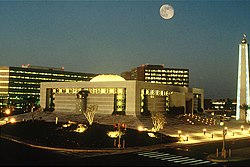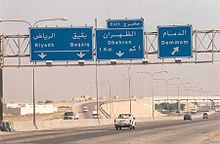| Revision as of 08:07, 12 September 2006 editReemaS (talk | contribs)26 editsNo edit summary← Previous edit | Revision as of 08:11, 12 September 2006 edit undoReemaS (talk | contribs)26 editsNo edit summaryNext edit → | ||
| Line 112: | Line 112: | ||
| Schools in Dhahran come under two sections: public (government-run) and private. Public schools (K-12), open to almost everyone, strictly adhere to teaching the curriculum exactly as provided by the Ministry of Education. Private schools also teach the ministry’s curriculum, but they have more freedom, often enhancing certain aspects, such as teaching more than just the ministry’s curriculum when teaching the English language. Dhahran Ahliyya Schools and al-Faysaliyyah are examples of private schools in Dhahran. | Schools in Dhahran come under two sections: public (government-run) and private. Public schools (K-12), open to almost everyone, strictly adhere to teaching the curriculum exactly as provided by the Ministry of Education. Private schools also teach the ministry’s curriculum, but they have more freedom, often enhancing certain aspects, such as teaching more than just the ministry’s curriculum when teaching the English language. Dhahran Ahliyya Schools and al-Faysaliyyah are examples of private schools in Dhahran. | ||
| There are several schools that teach the curriculum of their native countries such as the , Dhahran Academy, Dhahran Middle School (a school for Saudi Aramco employees‘ children), , and Al-Khobar French School. | There are several schools that teach the curriculum of their native countries such as the , Dhahran Academy, Dhahran Middle School (a school for Saudi Aramco employees‘ children), , and Al-Khobar French School. | ||
| Dhahran is also home to the ], and the Aramco Training Center (ATC), where many new employees of Saudi Aramco learn useful skills, such as English, Business Math, Physics, as well as computer skills. ] and ] are also located near the city. | Dhahran is also home to the ], and the Aramco Training Center (ATC), where many new employees of Saudi Aramco learn useful skills, such as English, Business Math, Physics, as well as computer skills. ] and ] are also located near the city. | ||
Revision as of 08:11, 12 September 2006
You must add a |reason= parameter to this Cleanup template – replace it with {{Cleanup|September 2006|reason=<Fill reason here>}}, or remove the Cleanup template.
| Saudi Aramco in Dhahran أرامكو السعودية في الظهران | |
|---|---|
 | |
| Location in the Kingdom of Saudi ArabiaLocation in the Kingdom of Saudi Arabia | |
| Province | Ash Sharqiyah |
| Government | |
| • Prince | Muhammad bin Fahd |
| Population | |
| • City | 11,300 |
| • Metro | 97,446 |
| Time zone | UTC+3 |
Dhahran (Arabic الظهران aẓ-Ẓahrān) in Saudi Arabia's Eastern Province. Dhahran is a major administrative center for the Saudi oil industry. Large oil reserves were first identified in the Dhahran area in 1931, and in 1935 Standard Oil of California (now Chevron Corporation) drilled the first commercially viable oil well. Standard Oil later established a subsidiary in Saudi Arabia called the Arabian American Oil Company (ARAMCO), the forerunner to the modern Saudi Aramco (now fully owned by the Saudi government).
Geography, Geology and Climate
Dhahran is a short distance west of downtown Khobar with its traditional shopping center, and about 15 km south of Dammam, both older Saudi port cities on the Persian Gulf. Looking farther afield, Dhahran is northeast of Abqaiq, and southeast of Qatif (a traditional Shi'ite oasis town) and, further north, Ras Tanura, a major oil port. The island nation of Bahrain is also within easy driving distance to the east (about 20 miles), across the King Fahd Causeway, from Khobar.
The patch of desert on which the city is built is hilly/rocky, and most of the earliest productive oil wells in the Saudi Arabia were drilled in the area, such as Dammam Well #7: "Prosperity Well," the first commercially viable oil well in Saudi Arabia in the 1930s. This later led to the selection of two barren nearby hills as the place for Aramco to construct its headquarters.
The Dhahran-Dammam area is one of two regions, the other being Jeddah, that were selected as potential sites to build the first Saudi nuclear reactor.
Dhahran’s climate is that of the desert, characterized by extremely hot, dry summers, and cold winters. Temperatures can rise to more than 50°C in the summer, coupled with extreme humidity (85%-100%), given the city’s proximity to the Persian Gulf. In winter, the temperature rarely falls below 2° or 3° C, with rain falling mostly between the months of November and May. The Shamal Winds usually blow across the city in the early months of the summer, bringing dust storms that can reduce visibility to a few meters. These winds can last for up to three months.
Economy
The economy of Dhahran as a city revolves to a certain degree around Saudi Aramco, the national oil company, which has its headquarters in Dhahran. The company is considered to be one of, if not the, largest oil company in the world with the largest oil reserves in the world ], and it produces more oil per day than any other country or company in the world. Most of the oil is exported, since local Saudi needs require only a tiny percentage of the total production. Saudi Aramco is also the largest oil exporter in the world. (See: Saudi Aramco)
Sixty-five years on, Dhahran is still Saudi Aramco's worldwide headquarters and the center of the company's finance, exploration, engineering, drilling services, medical services, materials supply and other company organisations.
There are also many other companies, both private and public, as well as branches of international companies in Dhahran.
Demographics
Main article: Demographics of Saudi Arabia
The population of Dhahran contains many expatriates from Asian countries, such as Bangladesh, India, Indonesian, Pakistan and the Philippines, as well as Westerners from the United States, Europe, South Africa and Australia. There are also many non-Saudi Arab nationals living in Dhahran, such as Lebanese, Egyptians, Palestinians, Syrians and Jordanians. According to a 2004 census the total population of the Dhahran municipality is 97,446.
Many companies that employ relatively large numbers of expats have built fenced-in compounds where most expats live, such as the Saudi Aramco Residential Camp in Dhahran, ROC, CCC, Al-Nada, Oasis, and many others. Within these compounds, residents are not required to wear the abaya (the black cloak women in Saudi Arabia are required to wear) and live in relative freedom, and several compounds have pools and recreation areas that are shared by the residents. There are also several neighborhoods, or suburbs, such as Hay Al-Doha (حي الدوحه) and Hay Al-Dana (حي الدانة), whose residents include Saudi nationals as well as expats.
Government, law, and security
Main article: Politics of Saudi Arabia
Dhahran is part of the Eastern Province (Ash Sharqiyah Province), the largest province in Saudi Arabia. The province is governed by Prince Mohammed bin Fahd bin Abdul Aziz al-Saud. Just like the rest of the country, the law of Shari’a, or Islamic law is adhered to. Following the Saudi Arabian municipal elections in 2005, members of the municipal councils were elected.
Dhahran is a relatively safe city. The Saudi Special Emergency Forces' Eastern Province headquarters are located in Dhahran near the Saudi Aramco residential camp. There are many security checkpoints throughout the city that have been in almost permanently in place since the Riyadh Compound Bombings.
Transportation

As center of the nation's oil industry, Dhahran enjoys excellent transportation resources both nationally and internationally.
The nation's excellent highway infrastructure was modernized extensively in the '70s and '80s and connects the Dhahran area with all major urban centers in the Kingdom such as Riyadh, Jeddah, Makkah, Medina, Dammam, etc. It is also connected to its neighbors Kuwait, Qatar, the nearby island nation of Bahrain via causeway, the United Arab Emirates and further north to Jordan, etc.
Formerly one of Saudi Arabia's three major international airports, Dhahran Airport (DHA) is now an airbase of the Royal Saudi Air Force. Now, the new airport, King Fahd International Airport (DMM), serves the entire metropolitan area: Dhahran, Dammam, and Al Khobar. Saudi Aramco Aviation has its own buildings and terminal where all Saudi Aramco flights originate.
Although rail service in Saudi Arabia plays a much more minor role today than 50 years ago, an industrial railroad with a station adjacent to Dhahran still exists, linking it to the capital Riyadh.
Public transportation is not wide-spread although it is available in a very limited manner. Taxi service is more popular that taking a bus. Saudi Aramco runs its own bus transportation, which connects the residential and industrial camps of the company, as well as connecting them to Dhahran and Khobar.
Communications and Media
Mobile communications are provided mainly by STC, and Mobily. Both companies of launched 3G services to their customers. STC also provides landlines through it Al-Hatif services, as well as providing internet services through Saudi Data. There are several Internet Service Providers such as Al-Alamiah, ArabNet, Nesma and many more. Both dial-up and DSL services are available.
There are several popular radio stations, such as Radio Sawa, Studio One 91.4, broadcast from Aramco, Bahrain Radio 96.5, and AFRTS.
Satellite television is predominant in the market, with Orbit Network and Showtime Arabia being the most popular, as well as the widespread Arabsat and Nilesat satellite channel operators.
Education
Schools in Dhahran come under two sections: public (government-run) and private. Public schools (K-12), open to almost everyone, strictly adhere to teaching the curriculum exactly as provided by the Ministry of Education. Private schools also teach the ministry’s curriculum, but they have more freedom, often enhancing certain aspects, such as teaching more than just the ministry’s curriculum when teaching the English language. Dhahran Ahliyya Schools and al-Faysaliyyah are examples of private schools in Dhahran.
There are several schools that teach the curriculum of their native countries such as the Dhahran British Grammar School, Dhahran Academy, Dhahran Middle School (a school for Saudi Aramco employees‘ children), Dhahran High School, and Al-Khobar French School.
Dhahran is also home to the King Fahd University for Petroleum and Minerals, and the Aramco Training Center (ATC), where many new employees of Saudi Aramco learn useful skills, such as English, Business Math, Physics, as well as computer skills. King Faisal University and Prince Mohammad bin Fahd University are also located near the city.
Dhahran in film and TV
- The West Wing: In one episode, the story plot was picketers outside the Aramco camp of Dhahran.
- CNN: A report about Dhahran was aired.
- In 1998 after the bias-motivated kidnapping and murder of Matthew Shepard, a Wyoming college student, the major American news networks would occasionally mention that the student's parents lived in Dhahran and worked for Aramco.
See also
External links
- Travel guide with photos
- Consulate General of the U.S. in Dhahran
- History of Dhahran (1950's)
- General information about Dhahran, useful for first time visitors
- List of Saudi ISPs
- Satellite Image from Google Maps
- Satellite Image from Wikimapia
| 1,000,000 and more | |
|---|---|
| 300,000-999,999 | |
| <300,000 | |
| Source: cdsi.gov.sa | |